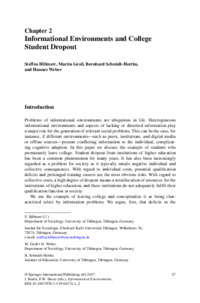Informational Environments and College Student DropoutSteffen Hillmert, Martin Groß, Bernhard Schmidt-Hertha, Hannes Weber
|
 |
 Diese Seite wurde seit 7 Jahren inhaltlich nicht mehr aktualisiert.
Unter Umständen ist sie nicht mehr aktuell.
Diese Seite wurde seit 7 Jahren inhaltlich nicht mehr aktualisiert.
Unter Umständen ist sie nicht mehr aktuell.
 Zusammenfassungen
Zusammenfassungen
 As to the environmental
factors that may impact student dropout from university, Chap. 2 focuses on
rules and regulations that constrain information use, in particular as they pertain
to grading procedures. Grading procedures might differ in several respects (e.g.,
whether students can participate in the grading, or in how far grades actually are
valid indicators of performance), and the chapter tracks how far the perceived
justice of grading procedures impacts student dropout. Moreover, the chapter takes
a look at individual precursors of student dropout.While dropout in itself reflects an
outcome of a motivational variable, the chapter investigates how far informational
competences of students (cognitive perspective) and social integration with other
students (social-interactive perspective) contribute to dropout decisions. The chapter
also reports on a large online survey that tracked individual and environmental
factors across various academic fields in Tübingen University, and the influence
of these factors on student dropout.
As to the environmental
factors that may impact student dropout from university, Chap. 2 focuses on
rules and regulations that constrain information use, in particular as they pertain
to grading procedures. Grading procedures might differ in several respects (e.g.,
whether students can participate in the grading, or in how far grades actually are
valid indicators of performance), and the chapter tracks how far the perceived
justice of grading procedures impacts student dropout. Moreover, the chapter takes
a look at individual precursors of student dropout.While dropout in itself reflects an
outcome of a motivational variable, the chapter investigates how far informational
competences of students (cognitive perspective) and social integration with other
students (social-interactive perspective) contribute to dropout decisions. The chapter
also reports on a large online survey that tracked individual and environmental
factors across various academic fields in Tübingen University, and the influence
of these factors on student dropout. In this chapter, an interdisciplinary research group of sociologists and educational scientists discusses how the informational environments of college students influence potential and actual dropout behavior. Previous research has identified academic performance and social integration as the key predictors of student dropout. Our focus is on a further explication of these aspects using information-related factors: media-related competency and information behavior, perceptions of fairness at college, and social integration into university life. Empirical analyses are based on data from a large online survey. We focus on both dropout intentions, as stated in the survey, as well as actual dropouts, as shown in administrative records around 1.5 years after the survey. We find that several factors related to information behavior, justice perceptions as well as social integration, significantly affect dropout intentions. These findings are surprisingly stable across fields of study groups as well as academic performance levels. On the other hand, actual dropouts are much harder to predict in comparison to stated preferences.
In this chapter, an interdisciplinary research group of sociologists and educational scientists discusses how the informational environments of college students influence potential and actual dropout behavior. Previous research has identified academic performance and social integration as the key predictors of student dropout. Our focus is on a further explication of these aspects using information-related factors: media-related competency and information behavior, perceptions of fairness at college, and social integration into university life. Empirical analyses are based on data from a large online survey. We focus on both dropout intentions, as stated in the survey, as well as actual dropouts, as shown in administrative records around 1.5 years after the survey. We find that several factors related to information behavior, justice perceptions as well as social integration, significantly affect dropout intentions. These findings are surprisingly stable across fields of study groups as well as academic performance levels. On the other hand, actual dropouts are much harder to predict in comparison to stated preferences. Dieses Kapitel erwähnt ...
Dieses Kapitel erwähnt ...
 Anderswo finden
Anderswo finden
 Volltext dieses Dokuments
Volltext dieses Dokuments
 |  Informational Environments and College Student Dropout: Artikel als Volltext bei Springerlink ( Informational Environments and College Student Dropout: Artikel als Volltext bei Springerlink ( : :  , 211 kByte; , 211 kByte;  : :  ) ) |
 Anderswo suchen
Anderswo suchen 
 Beat und dieses Kapitel
Beat und dieses Kapitel
Beat hat Dieses Kapitel während seiner Zeit am Institut für Medien und Schule (IMS) ins Biblionetz aufgenommen. Er hat Dieses Kapitel einmalig erfasst und bisher nicht mehr bearbeitet. Beat besitzt kein physisches, aber ein digitales Exemplar. Eine digitale Version ist auf dem Internet verfügbar (s.o.). Aufgrund der wenigen Einträge im Biblionetz scheint er es nicht wirklich gelesen zu haben. Es gibt bisher auch nur wenige Objekte im Biblionetz, die dieses Werk zitieren.











 Biblionetz-History
Biblionetz-History